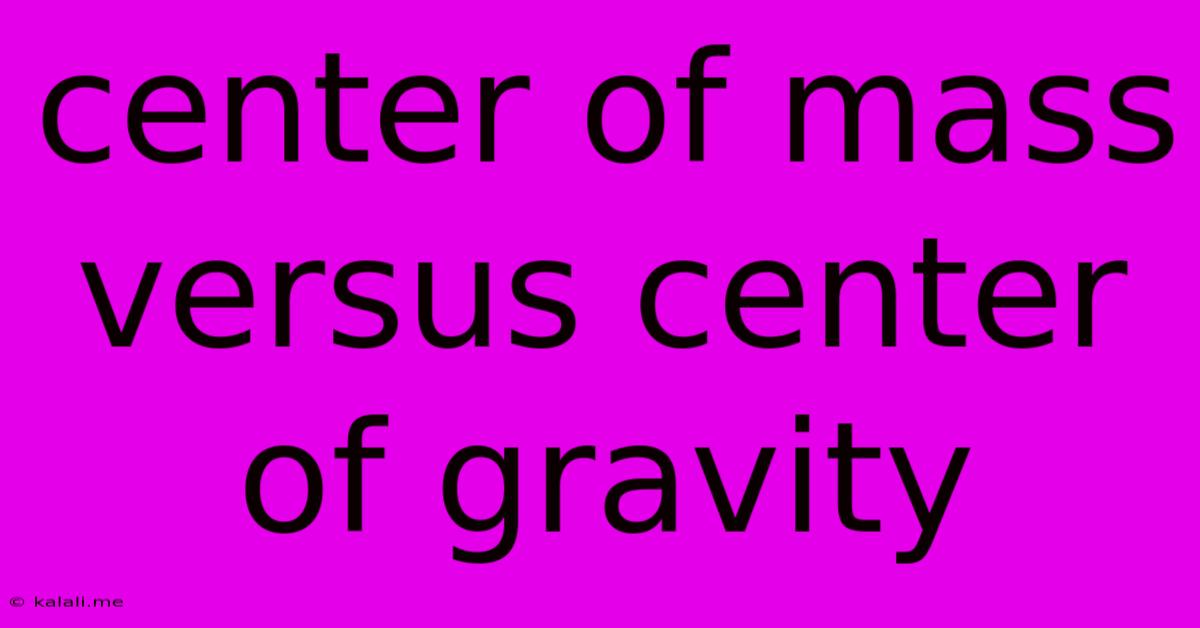Center Of Mass Versus Center Of Gravity
Kalali
May 30, 2025 · 4 min read

Table of Contents
Center of Mass vs. Center of Gravity: Understanding the Difference
The terms "center of mass" and "center of gravity" are often used interchangeably, leading to confusion. While closely related, they represent distinct concepts with subtle yet crucial differences. This article will clarify the distinction between these two important physics concepts, exploring their definitions, calculations, and practical implications. Understanding this difference is key for various fields, from engineering and physics to aerospace and sports.
What is the Center of Mass?
The center of mass (COM) is the average position of all the mass within a system. Imagine a perfectly balanced seesaw; the center of mass is the point where the seesaw would balance perfectly, regardless of the gravitational field. It's a purely geometric property, dependent only on the distribution of mass within an object or system. The location of the COM doesn't change even if the object is moved to a different planet with a different gravitational pull. Calculating the COM involves finding the weighted average of the positions of all the individual mass elements within the system. For a simple system with discrete masses, this is relatively straightforward. For complex systems with continuous mass distributions, integration techniques are required.
Key characteristics of the Center of Mass:
- Geometric property: Independent of gravitational field.
- Weighted average of positions: Considers the distribution of mass.
- Point of balance: The object would balance perfectly if supported at this point.
- Useful in various fields: From mechanics to robotics.
What is the Center of Gravity?
The center of gravity (COG) is the point where the entire weight of an object can be considered to act. It's the point where the gravitational force acts on an object. Unlike the COM, the COG is directly affected by the gravitational field. If the gravitational field is uniform (like near the Earth's surface), then the COM and COG are practically identical. However, in non-uniform gravitational fields, such as in space near a large celestial body, the COM and COG will differ. The COG is the point around which an object will rotate if subjected to a torque.
Key characteristics of the Center of Gravity:
- Gravitational property: Dependent on the gravitational field.
- Point of weight application: The object's weight acts as if it's concentrated at this point.
- Point of rotation: The object will rotate about this point under the influence of torque.
- Approximates COM in uniform fields: Near the Earth's surface, they are almost identical.
The Crucial Difference: Uniform vs. Non-Uniform Gravitational Fields
The key difference lies in the influence of gravity. In a uniform gravitational field (like the one we experience on Earth), the center of mass and the center of gravity are virtually the same. This is because the gravitational force acts equally on all parts of the object, and their weighted average position remains the same. However, in a non-uniform gravitational field, the gravitational force varies across the object. This means the weighted average of the gravitational forces acting on different mass elements will produce a different point compared to the simple weighted average of positions (COM). This leads to a separation between the COM and COG.
Practical Implications and Examples:
- Stability of objects: The position of the COG relative to the base of support determines the stability of an object. A lower COG generally leads to greater stability.
- Aircraft design: Understanding the COG is crucial in aircraft design to ensure proper balance and maneuverability.
- Robotics: Knowing the COM is essential for controlling the movement and balance of robots.
- Sports: Athletes use their understanding of COM and COG (often unconsciously) to improve performance in activities like gymnastics, skiing, and cycling.
In Conclusion:
While often used interchangeably, the center of mass and center of gravity are distinct concepts. The center of mass is a purely geometric property, independent of gravity, representing the average position of mass. The center of gravity is the point where the weight of an object is considered to act, and it is affected by the gravitational field. In most everyday scenarios on Earth, they are virtually identical due to the uniform gravitational field. However, in non-uniform gravitational fields, these concepts diverge, highlighting the importance of understanding their individual definitions and applications.
Latest Posts
Latest Posts
-
How To Call Australia From Us
May 31, 2025
-
Mtg If You Gained Life This Turn
May 31, 2025
-
Car Ac Not Blowing Air From Front Vents
May 31, 2025
-
The Making And Authorized Distribution Of This Film Supported Over
May 31, 2025
-
How To Get Foil Off Bottom Of Oven
May 31, 2025
Related Post
Thank you for visiting our website which covers about Center Of Mass Versus Center Of Gravity . We hope the information provided has been useful to you. Feel free to contact us if you have any questions or need further assistance. See you next time and don't miss to bookmark.